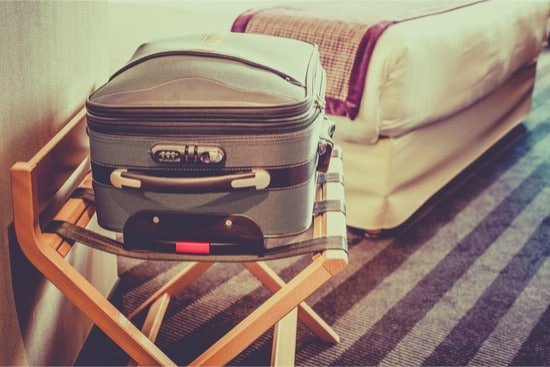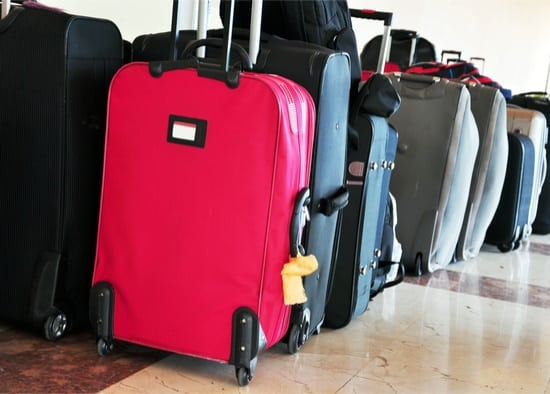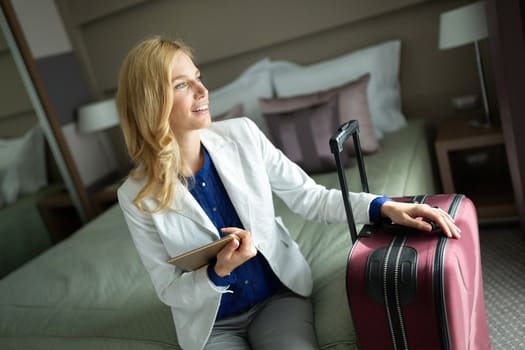Vacations are supposed to be fun, but bringing home bed bugs would ruin that happy feeling instantly. Nobody wants to find bed bugs when they return home from your well-earned break. Unfortunately, bed bugs get into luggage. They find a way inside and come home with you.
Spray your suitcase with a bed bug repellent. Use a luggage cover or wrap your luggage in plastic bags so bed bugs can’t get in after you arrive. Zip up your suitcase when not in use. Store it on a table, not the floor or bed where bed bugs can be found. Bed bugs are attracted to luggage because of dirty clothes (human scent), so bag these up.
At home, you can wash your worn clothes at a temperature that will kill bed bugs. That’s not nearly as easy to do when you’re on vacation. We all tend to leave all of the hard work until you get home. Unfortunately, that’s how bed bugs find their way into luggage and come home with you.
Can Bed Bugs Live in Your Luggage?
One of the main ways that bed bugs get across the country is through luggage. A traveler will pick them up on vacation, from a bed bug infested hotel room. When they bring their luggage home, they’re also bringing home bed bugs.
Above all, bed bugs like dark, secluded places. Your luggage is exactly that as it offers:
- Lots of cracks and crevices, like pockets or the gaps between your things
- A place for them to sit that’s near to you, i.e., the floor near your hotel bed
- Things that smell like people, i.e., your clothes
The bed bug won’t live in there forever. When you arrive home with them, they’ll search for a new harborage.
The issue is that it’s only typically egg-laying females that explore. Egg-laying females search out new and safe places to lay their eggs. Males and unmated females tend to stay put.
This means that the bed bug you picked up is likely to start a new infestation. A mated female can lay eggs for many weeks afterward, provided she has access to food.
In her new hiding place, she’ll feed on you and lay her eggs. She’ll eventually mate with her young, and produce a full-size infestation.
Can Bed Bugs Live in Clothes?
Bed bugs like clothes, for several reasons. They offer lots of cracks, gaps, and dark hiding places. A pocket, for example, is perfect for a bed bug to hide in.
They are also comfortable laying their eggs on fabric. Most infestations are on mattresses, after all, which are made of fabric. Their eggs glue down well on cloth and similar materials. So, they can live, digest and lay eggs from a base in your clothes.
To be clear, though, they can’t eat or bite through fabric. Some bugs can, but bed bugs can’t. Bed bugs only feed on blood. So, if they don’t have access to you, they won’t live in clothing.
And bed bugs don’t live in clothes that you’re wearing, only discarded items. Whenever you get close to them, they scatter. They only want to get near you when they’re hungry.
But in the context of traveling, bed bugs can live in clothes.
Can Bed Bugs Get into Closed Luggage?
Many pests can burrow, either to access food or a safe location. But bed bugs can’t burrow. They lack the strong jaws or forelegs needed to do so. This means that bed bugs can’t get inside your luggage if it’s closed.
But just because they can’t get inside, that doesn’t mean you’re safe from them. There are still several ways that they can hitch a ride, including:
- In pockets on the front, back or side of your luggage
- Under the piping around each edge of your case
- In the wheel or handle wells
Essentially, any crack or gap is good enough for them to hide in. This is something people typically overlook. They might check the inside of their luggage, but not the outside.
You have to check both to completely prevent bed bugs.
Can Bed Bugs Get into Zippered Luggage?
A zipper presents a different problem. Bed bugs are well-known for slipping into tiny cracks, e.g., in a wall or floorboard. And zippers have little gaps they might fit through.
Bed bugs are thin, but not that thin. They’re too big. Bed bugs are around the size of an apple seed. This makes them too big to fit through a zip, so again, they can’t get into closed luggage.
But zips still offer ways for them to hide. For example, many zips have a fabric cover over them. Bed bugs can hide underneath these. And if the zip is secure and doesn’t move, they could even hide under the zipper pull itself.
There are so many ways to get bed bugs in your luggage. Let’s learn how to avoid that.

How to Prevent Bed Bugs in Luggage
The last thing you want to think about when you’re on vacation is bed bugs. But if you avoid thinking about it now, you could have a much bigger problem on your hands. An infestation.
Below are our advice and tips on how to avoid bed bugs when traveling. They start with preparations for before you leave, and move on to what you do when you arrive.
1) Buy Bed Bug Proof Luggage Covers
There are different kinds of luggage cover. The majority of bed bug luggage protectors sit inside the luggage itself. The point is to stop bed bugs from getting in your clothes. But these don’t protect your luggage adequately:
- The bed bugs can still get inside, and hide around the edge of the protector
- They can still hide in the wheel or handle wells
- It doesn’t stop them sitting under the piping on the outside of your luggage
You’ll need a protector that fits over your luggage. Basic plastic luggage covers provide some protection. They fit over the entire suitcase, and are usually clear so that you can see inside.
These stop the bed bugs from accessing many parts of your luggage. For example, they can’t reach the handles. And sometimes they cover the zips. They, therefore, provide some protection. But they usually have an open gap at the bottom.
You could also wrap your luggage in a plastic bag. Bed bugs can’t bite or burrow through plastic. If you keep your luggage in a sealed garbage bag, there’s no way for them to get inside.
When wrapping your luggage, check for wrinkles on the surface. The smoother the surface, the fewer places a bed bug can hide.
2) Use Bed Bug Luggage Spray Repellent
Bed bugs display natural avoidance behavior in response to anything toxic to them. They use smell to navigate the world safely, and will walk around areas that are sprayed with pesticide.
At home, it’s not wise to use a spray solely as a repellent. If you do, you encourage bed bugs to move around your home. They can then set up extra infestations in places they weren’t before.

But when you’re traveling, using a repellent is an excellent idea. By spraying your luggage, you discourage them from hiding and coming home with you.
It would be best to use a pesticide rather than a DIY bed bug spray. Synthetic pesticides are designed to linger after being used. The active chemicals then kill and repel bed bugs for weeks afterward.
DIY sprays, such as peppermint oil only kill on contact. That’s good, but it means they can’t repel bed bugs afterward.
So to repel any potential invaders, spray each part of your luggage. You don’t need to spray everything inside. Spray the suitcase itself, so that the bed bugs will be repelled from the outside.
If you spray your luggage, and put an impermeable plastic cover on it, you’re ready to go.
3) Check for Bed Bugs When You Arrive
Bed bugs are creatures of habit. They almost always feed on people, and live in the same places. This is their weakness. It means you can find them before they get a chance to bite you.
When you arrive at your hotel, check for bed bugs straight away. They’re likely to be in one of the following places:
- On the underside of the mattress
- Under nearby furniture
- Between the head of the bed and the wall
- Between the baseboard and the wall
- In the gap between the carpet and the wall
Examine any small gap or crack you can find. If you find any, you can ask to switch rooms. Ask for one on another floor, and check for any there.
If you have the time, you could ask for a refund and go to another hotel. Hotels will always allow this, because you can sue for bed bug bites in hotels.
Searching for bed bugs is the last thing you want to do on holiday. But it’s far preferable to bringing home an infestation.
4) Keep Your Luggage Off the Floor
While it’s best practice to keep your luggage sealed all the time, that’s impossible. You have to get your clothes out each morning, and any books, electronics, and other items too.
Rather than leaving your luggage on the floor when you open it, keep it on a table. There are several reasons why this is preferable:
- Live near the floor. They can live around the edge of the carpet, or in floorboards.
- Avoid daylight. If your bag is on the floor, they could run through the shade to reach it.
- Avoid people when they aren’t feeding. Your luggage is closer to you when it’s on a table.
- Less of a problem if you forget to close it. Bed bugs can climb. But they’ll have a harder time finding your luggage when it’s up high.
Also, avoid putting your luggage on the bed at any point. This would give the bed bugs the best chance of finding it.
5) Keep Your Luggage Zippered
When you’re done with your luggage, zip it up again. The less time that your luggage is open, the less time there is for bed bugs to get inside.
This has the added effect of preventing the bed bugs from smelling your things. Bed bugs are lured by CO2 and heat mostly, but also the smell of people. If they can smell ‘people’ on the things in your luggage, they will be drawn to it.
By closing your luggage, you stop them from sniffing out your things. Ideally, you should put your luggage back in its protective bag. This further protects your luggage by stopping the bugs even coming near it.
6) Bag Your Used Clothes Separately
When you’re on holiday, it’s tempting to be untidy. But by being untidy, you increase the chance of an infestation. That’s because bed bugs are attracted to your worn clothes.
A study in Scientific Reports found that bed bugs were attracted to bags containing dirty clothes. The scientists tested dirty clothes against clean clothes. They found that more than double the amount are attracted to clothes you’ve worn for a day.

Even if you don’t sweat much, your clothes still smell like you after you wear them. Bed bugs are attracted to the scent of people, so are attracted to worn clothes too.
If you leave worn clothes on the floor, bed bugs could hide inside. Worse still is if you leave your worn clothes in your open luggage.
To avoid this problem, bag your clothes after you wear them. Bed bugs can’t smell or burrow through plastic.
The outside of the bag may still smell like you, if you or the clothes touched it. So keep it inside your sealed, sprayed luggage.
7) Check Before You Leave
It’s typically only egg-laying females that explore. If you catch a single bed bug, it’s likely to be an egg-laying female.
This is both an advantage and a disadvantage. It means that one bed bug on its own could start an infestation in your home. But it also means that if you find that bed bug before you leave, your problem’s solved.
Check your luggage before you leave. Check every part of your luggage, inside and out. When emptying your case, empty your belongings into a large bag rather than putting them on the ground or bed.
If you find any bed bugs, kill them any way you like. Squash them or flush them away, for example.
How to Tell If You Brought Bed Bugs Home
There’s no way to tell for certain that you managed to avoid bringing bed bugs home with you. The best you can do is check your luggage. However, there are tools you can use that will identify an infestation.
They have the added benefit of killing the one or two bugs you might have brought home.
1) Bed Bug Interceptors
Bed bug interceptors sit around the feet of your bed. They’re small traps that the bed bugs can climb into, but not out of. They’re typically made of plastic, and are either small circles or squares.
They have an outer wall and an inner wall, and a ‘well’ in the middle. The bed bug can climb the outer wall, but not the inner wall. If you brought a bed bug home, when it tries to feed, you’ll find it.
The only exception is tropical bed bugs. The tropical kind can climb out of traps like these. You should fill the well with a little water, because no kind of bed bug can swim.
Having interceptors lowers the chance that you catch an infestation. If you bring one home, it will find a temporary hiding place. Then at night, when they get hungry, they’ll want to feed. But they never will because they can’t reach you.
The only way to avoid an interceptor is if you put the bed bugs on your bed, yourself. Avoid placing your luggage or unlaundered holiday clothes on your bed to stop this happening.
2) Diatomaceous Earth
Diatomaceous earth is a fine white powder made from rock. It scratches away the bed bug’s outer waxy layer. This makes them dry out quite quickly.
You can put diatomaceous earth around your bed. You can tell if a bed bug walks through it. They would leave tiny marks, and spread some of it around.
Again, though, the point is more to kill the bed bug than spot it.
3) Bed Bug Glue Traps
Bed bug glue traps, also known as bed bug monitors, are what exterminators use. They are small sticky rings that sit around the feet of your bed.
The idea is similar to interceptors. Any time a bed bug walks over it, they’ll get stuck. However, anecdotal evidence of how bed bugs avoid walking over tape shows that it doesn’t work that well.
How to Get Rid of Bed Bugs in Luggage
Nobody’s perfect, so it’s possible that you missed one or two bed bugs in your luggage. To avoid bringing them home with you, follow the tips below.
Bed Bug Quarantine
When you get home, immediately launder your clothes. Empty the dirty clothes bag directly into the washing machine, and throw the bag away. Laundering kills 100% of bed bugs and their eggs. This applies both to dirty and clean clothes.
Keep your other belongings in a sealed plastic tub when you get home. The bed bugs inside won’t starve to death. But they also can’t start an infestation, as they can’t get out.
Bed Bug Killer Spray
For anything you can’t keep sealed up, consider spraying it. DIY sprays like tea tree oil, lavender and peppermint kill on contact. Pesticide sprays are more effective—they kill more bed bugs, and quicker. They also linger and kill for weeks.
Whichever spray you use, give your entire suitcase a once-over. This should kill any bed bugs that you missed.
The issue with any form of treatment at this point is that bed bugs are smart. The moment you get home with one, they’ll want to find somewhere safe and secure. This means heading for nearby furniture or bedding.
It’s far better to avoid getting bed bugs in luggage at all. Follow the hints described above, and there’s little chance you’ll bring home bed bugs in luggage.


Does any company make a travel size bed bug spray?